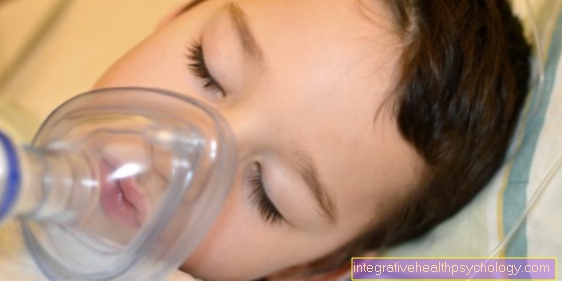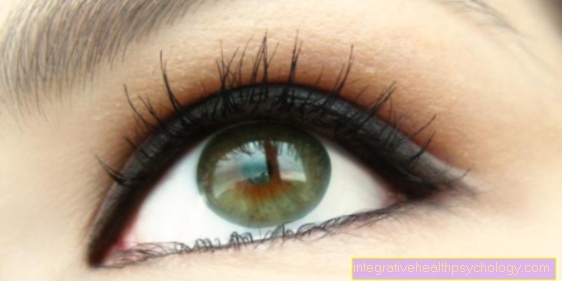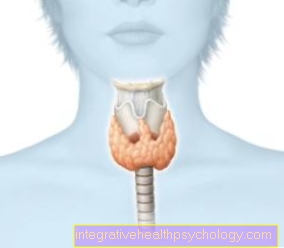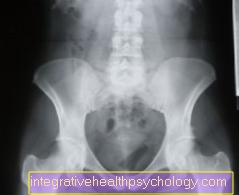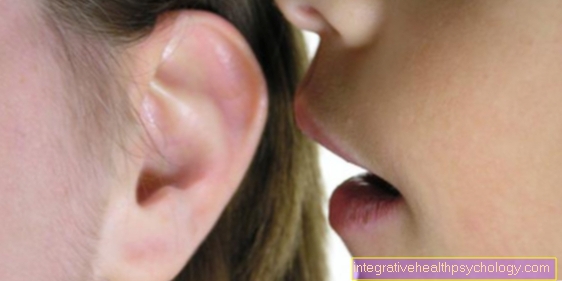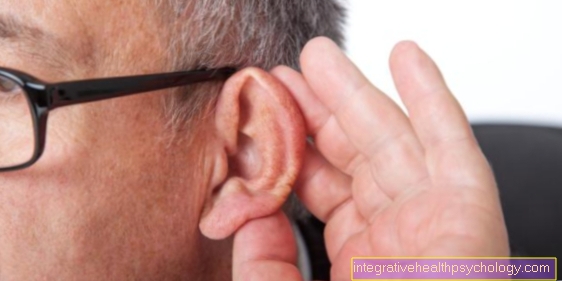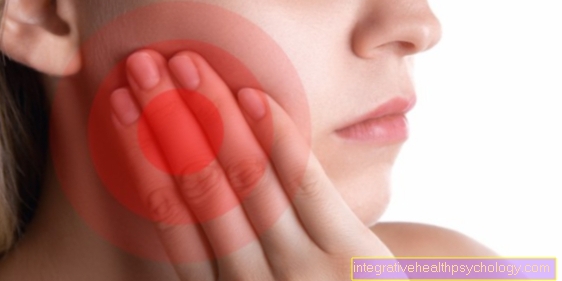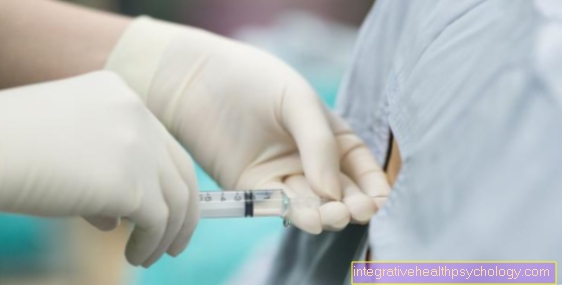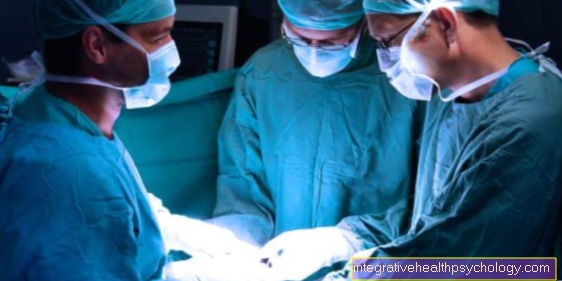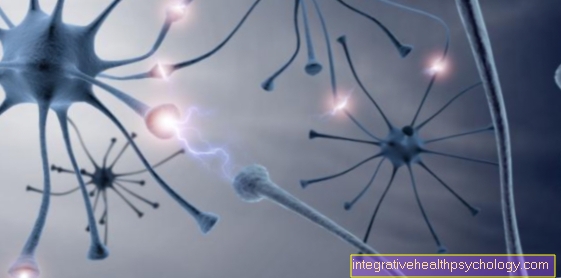Spina bifida
definition
Spina bifida is a congenital malformation caused by a disruption of the so-called neural tube during fetal development. The neural tube usually closes to form the spinal canal. This happens in the third to fourth week of pregnancy. If this closure does not occur, a spina bifida results.
Synonyms in a broader sense
Open spine, open back, spinal cord
Occurrence (epidemiology)
Defects of the neural tube during development in the womb are the most common malformations of the nervous system. In Germany this applies to about one in 1000 pregnancies. Due to the better prevention of pregnant women, the incidence (occurrence) has decreased sharply.
Causes of Spina Bifida
How exactly the defect of the neural tube arises is still unclear. Environmental factors and a lack of folic acid supply to the fetus seem to play a major role. The lack of folic acid in the mother in the third and fourth weeks of pregnancy has a major impact on the development of the fetal spinal canal.
Normally the parts of the vertebral arches fuse together and form the spinal canal. The spinal cord is protected by meninges in the nerve water.In spina bifida, this canal is not completely closed because one or more vertebral arches do not close at one point. The spinal cord can now emerge from this gap together with the nerve fluid.
Forms of spina bifida
There are two forms of spina bifida:
- Spina bifida occulta (closed / hidden spina bifida)
- Spina bifida cystica (cystic spina bifida)
In the form of spina bifida occulta, there is only a defect in the bony structures around the spinal cord, i.e. the vertebrae. The vertebral arches are not closed. As a rule, this form of spina bifida is asymptomatic.
The malformation is only noticed during the X-ray.
Symptoms are only present if the malformation also affects the spinal cord.
A so-called dermal sinus (sinus pilonidales) is often associated with the spina bifida occulta. This is a small canal that begins on the surface of the skin and ends either inside or outside the spinal cord. It appears as a pore and is usually more hairy than the surrounding area. If the sinus is connected to the spinal cord, meningitis can often occur. This is a serious complication at any age.
The spina bifida cystica is not only the bony coat that surrounds the spinal cord, malformed, but also the spinal cord itself is affected. The spinal cord membranes bulge out through the gap formed by the unclosed vertebral arches. Often the region of the lumbar vertebrae (lumbar vertebrae) and sacral vertebrae (sacral vertebrae) is affected. Roughly speaking, these vertebral groups sit between and above the pelvic bones. The protrusions created here are filled with nerve water and can be differentiated according to their content.
There are forms in which only the nerve water is contained. Other forms of these cysts also include spinal cord tissue and nerve roots. Cysts are fluid-filled cavities. In the worst case, an entire part of the spinal cord bulges out of the gap.
Spina bifida aperta
The spina bifida aperta ("obvious" spina bifida; also Spina bifida cystica) describes a terminal disorder of the bony vertebral arch.
This means that the rear part of a vertebral body, the so-called vertebral arch, is not or only partially present.
This part is usually intended to protect the spinal cord that lies within the vertebral arch. Due to the terminal disorder, the spinal cord has lost its bony protection. In contrast to the spina bifida occulta, in the spina bifida aperta the meninges (Meninges, synonymous with spinal cord membranes) and possibly the spinal cord not in the right place, but bulge outwards.
As a result, the skin over the area of the defect thins and bulges outward like cauliflower. The meninges then lie in this thin skin sac (Meningocele) and possibly also the spinal cord (Meningomyeolocele).
Meninges and spinal cord have protruded (so they are no longer in their proper place, but have emerged through the opening in the spine), similar to intestinal loops in an inguinal hernia.
Depending on the severity, there may also be water retention in the hernial sac (Myelocystocele, myelocystomeningocele).
In the strongest form, the Myeloschisis spoken. The not fully matured spinal cord, known as the neural plate, lies open on the back without being covered by protective meninges or skin.
The spina bifida aperta is usually located in the lower lumbar spine or in the sacrum (Sacrum). It is usually associated with much more severe symptoms than spina bifida occulta, such as paralysis, malpositions of the feet, sensory disorders, lack of control over the bladder and rectum.
Hydrocephalus (head of water) is also more common in spina bifida aperta.
Spina bifida oculta
The spina bifida occulta ("hidden / hidden" spina bifida) also describes a terminal disorder of the bony vertebral arch.
Here, too, the spinal cord has lost its bony protection. In contrast to the spina bifida aperta, the spinal cord and meninges are not affected by the terminal disorder, but are fully developed in the place intended for them.
The skin above is also intact. Often people with spina bifida occulta have no symptoms at all and the condition is discovered at some point by chance during an X-ray or the like.
As long as there are no symptoms, spina bifida occulta has no further medical significance. In some cases it can be noticed by skin changes such as increased hair (hypertrichosis) at the site of the spina bifida occulta or by a dermal sinus. A dermal sinus is a small passage in the skin that ends blindly.
Meningocele / Myelomeningocele
A meningo- or myelomeningocele is a spina bifida aperta (also Spina bifida cystica).
Similar to an inguinal hernia, when the intestine is in a hernial sac, the meninges with (myelomeningocele) or without (meningocele) spinal cord are in a skin sac at the site of the spina bifida.
Normally, both the skin sac and the meninges are closed so that the very sensitive spinal cord is at least slightly protected.
Sometimes there is also fluid stored in the hernial sac, so that one can speak of a cyst.
Symptoms / complaints of spina bifida
The main complaints are neurological disorders. The extent is very different from patient to patient. Paralysis, muscle weakness, sensory disorders of the skin and even urinary and fecal incontinence are possible. Mentally, however, the children's development is quite normal.
The severity and type of symptoms depend on the extent of the damage. If the spinal cord bulges into the existing gap in the spinal canal and is possibly pinched, the symptoms are more serious.
One complication of spina bifida is the so-called Arnold-Chiari syndrome: The leaked spinal cord creates a pull down on all parts of the CNS (central nervous system) located above. Since the spinal cord is in direct connection with the cerebrum and cerebellum, this can also be damaged. If the pull is strong enough, it pulls the spinal cord down from the occipital opening. The cerebellum, which lies directly above the occipital opening in the cranial cavity, may become pinched. Above all, however, the train impedes the circulation of nerve water.
Since the nerve water is formed in the hollow space system, the ventricles, of the brain and drains downwards, it accumulates. The "water head" (med .: Hydrocephalus).
Read more on this topic at: Head of water in the baby
Pain in spina bifida
Since nerve fibers are less well protected in spina bifida, more pain can occur.
Legs and rump in particular are often painful and more sensitive to touch than in healthy people.
Certain movements can also be painful. If there is paralysis, additional pain can occur due to the imbalance between different muscle groups.
In particular, physiotherapy with instructions on certain exercises can help here.
Spina bifida with hydrocephalus
Particularly in spina bifida aperta, a so-called water head (Hydrocephalus) come.
Hydrocephalus is an increased occurrence of brain water (Liquor).
Normally, the liquor washes around the brain and the spinal cord and is also located in cavities in the brain (liquor spaces, cerebral ventricles).
The cerebral water is especially formed in the cerebrospinal fluid spaces of the brain and from there slowly flows downwards and washes around the spinal cord. There it is reabsorbed again, i.e. ultimately slowly drained away. So the cerebral water mainly flows through the large skull hole (Foramen magnum), through which the brain stem and spinal cord also pass from the brain into the spine, out of the head.
If parts of the spinal cord are present in a hernial sac in spina bifida aperta, the entire brain is pulled down. Parts of the brain stem and cerebellum that normally reside in the skull are pulled down and clog the large skull hole.
This leads to the fact that the brain water can no longer flow downwards and collects in and around the brain. This constellation is called the Arnold-Chiari deformity. The production of brain water is not stopped. In babies, the skull bones are still soft and sometimes not properly fused together (e.g. fontanel), which is why the skull sometimes expands to grotesque dimensions.
Read more on the topic: Therapy of the water head
Furthermore, the hydrocephalus manifests itself with nausea, vomiting, cranial nerve paralysis, sunset phenomenon in which the eyes are rolled downwards, visual disturbances, headaches and epileptic seizures, which are triggered by the increased pressure on the brain.
Consequences of spina bifida
The consequences of spina bifida depend on the number of nerve fibers from the spinal cord that are affected.
Spina bifida occulta usually occurs without symptoms or consequences.
Only superficial changes in the skin over the affected area can occur (hairiness, darker skin, dermal sinus).
If nerve fibers are affected (in spina bifida aperta), serious disabilities can occur.
Since a spina bifida aperta usually occurs on the lower back, paralysis and sensory disturbances in particular affect the legs, and disturbances in pain perception can sometimes occur.
Club feet are common. Many children are unable to walk and use wheelchairs.
The paralysis can also lead to a curvature of the spine (Scoliosis). The bladder and rectum can also be affected, which leads to urinary and fecal incontinence (no control over the passing of urine or stool).
Urinary incontinence is usually associated with frequent urinary tract infections. If hydrocephalus is not treated, permanent damage to vision and hearing can result. Epilepsy and severe brain damage can also occur.
Inheritance in spina bifida
So far there is no clear evidence that suggests that spina bifida is inherited. However, it cannot be ruled out with absolute certainty that there are genetic factors influencing the disease.
It is certain, however, that a deficiency in folic acid in the pregnant mother is associated with an increased risk of spina bifida.
Certain drugs (such as the epilepsy drug valproate) also increase the risk that the unborn child will develop spina bifida. In general, spina bifida is one of the most common malformations in children.
Life expectancy in spina bifida
People born with spina bifida occulta usually have a normal life expectancy. If a dermal sinus has not been recognized as extending to the meninges of the spinal cord, repeated meningitis (Meningitis) occur, which under certain circumstances can damage the whole body, which could shorten life expectancy.
With spina bifida aperta, life expectancy is heavily dependent on the extent of the incident. In general, it can be said that people with spina bifida aperta are mostly dependent on the help of others and on medical help and care for their entire life.
If this runs optimally, an approximately normal life expectancy is assumed. If serious consequences have already occurred in the early course, such as hydrocephalus with brain damage or repeated kidney infections due to urinary incontinence, then one must assume a lower life expectancy.
It is impossible to make a general prediction, which is why this question should be asked individually for each case.
It can be summarized that the more severe the symptoms and restrictions, the lower the life expectancy in most cases.
Diagnosis of spina bifida
Spina bifida occulta is usually an incidental finding on X-rays. An incidental dermal sinus (pilonid sinus) is noticeable due to the protrusion of the skin and the thicker hair in this area.
However, prenatal ultrasound examinations are crucial in the diagnosis of spina bifida. This malformation can already be detected in the womb by sonography.
A protein can be determined in the mother's amniotic fluid that can provide information about the development of the child: alpha-fetoprotein (AFP).
If the child is born with such a defect, an MRI (magnetic resonance tomography) can help to identify the exact extent of the malformation.
MRI of the lumbar spine in spina bifida
An MRI (magnetic resonance tomography, magnetic resonance imaging) of the lumbar spine (lumbar spine) is usually not necessary if a spina bifida is suspected, as normally only the spina bifida aperta causes problems and this is usually visible to the naked eye.
Often this can already be recognized in ultrasound examinations before the child is born. Nevertheless, it can make sense to do an MRI to see exactly whether there is also the spinal cord in the skin sac (hernial sac) of a spina bifida aperta.
Otherwise, an MRI is only appropriate in the case of unclear symptoms (such as certain foot deformities in newborns / babies) that may be associated with spina bifida. This can be used to assess whether spina bifida, which usually occurs in the lumbar spine or sacrum, is present. If there are certain other abnormalities, such as a dermal sinus, an MRI can be done to assess the exact anatomy of the disorder.
An MRI of the pregnant woman can make more sense to clarify ambiguous ultrasound examinations. These usually come into question from the 19th week of pregnancy.
Therapy of spina bifida
A spina bifida aperta should be surgically closed as quickly as possible to prevent the ingress and rise of germs and thus to prevent infections of the nervous system.
Surgery significantly improves the chances of survival, but consequential damage cannot always be ruled out. The main aim of long-term care is to avoid complications. As a rule, life-long medical care is necessary.
With hydrocephalus (head of water), draining the excess nerve water is of great importance. For this purpose, a shunt is placed, which drains the nerve water. A shunt is an artificially implanted canal. This shunt can drain the nerve water into the atrium or into the abdominal cavity.
Prophylaxis of spina bifida
To prevent spina bifida, the mother has to consume sufficient folic acid, a vitamin, during pregnancy. Neural tube defects could thus be prevented.
If pregnancy is planned, folic acid supplements (4 mg / day) should be taken at least 4 weeks in advance. However, this prophylaxis is only useful in the first few weeks of pregnancy. After that, the development of the neural tube is complete and can no longer be influenced.
If you want to have children, you should take 4 mg of folic acid daily before conception and up to 4 weeks after conception.
Prognosis of spina bifida
The spina bifida occulta has a good prognosis. Mostly it is a chance finding during the X-ray. In spina bifida cystica, the prognosis depends on the location and extent of the cyst. Most of the time, the children are tied to a wheelchair for their entire life.
Summary
Spina bifida is a congenital malformation of the spinal canal. Due to the lack of folic acid in the third and fourth week of pregnancy, the spinal canal only partially closes off at one point.
It can lead to leakage of nerve water, but also spinal cord. There are open and hidden forms. Some can be seen directly, while others are more of an incidental finding on the X-ray.
The latter usually do not cause any complaints. In spina bifida, when cysts emerge from the skin, symptoms range from paralysis to bladder dysfunction. Surgical closure is usually carried out to avoid infections. Pregnant women should consume sufficient folic acid as a preventive measure.


